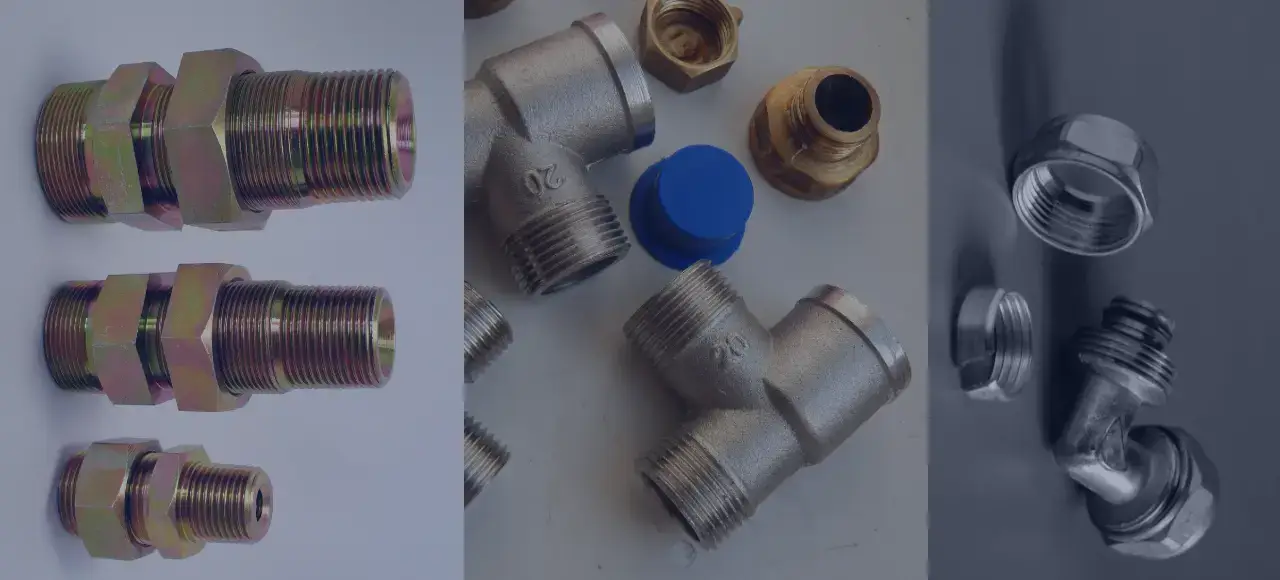Adapter fittings serve as intermediaries, allowing the seamless flow of fluids, gases, or electrical signals between incompatible components. Discover some prominent types that illustrate their adaptability.
Types of adapter fittings
Threaded adapters
Threaded adapters are connector components facilitating connections between parts with different thread types or sizes. They consist of male and female ends with varying thread configurations, enabling parts to be securely joined despite thread incompatibilities.
Quick-connect adapters
Quick-connect fittings epitomize efficiency in motion. Commonly used in hydraulic, pneumatic, and fluid transfer systems, these fittings allow rapid and tool-free assembly and disassembly. This speed enhances maintenance and operational flexibility.
Reducing adapters
Reducing adapters are great equalizers, seamlessly joining components with dissimilar diameters. These fittings ensure that fluid or gas flow remains unimpeded even when transitioning from a larger to a smaller conduit.
Flange adapters
Operating in high-pressure environments requires a special breed of connectors. Flange adapters step up to the plate, expertly joining pipes or components with flanged ends, forming a robust and sealed connection that can withstand the demands of heavy-duty applications.
Compression adapters
In situations where reliability is paramount, compression fittings shine. With their simple yet effective design, these fittings create a tight and leak-resistant connection, which is vital in plumbing and gas systems.
Barbed adapters
With their modest yet effective barbs, barbed fittings cater to low-pressure applications, such as irrigation systems. Their unassuming design belies their importance in maintaining a secure grip on hoses, preventing leaks, and ensuring consistent flow.
Camlock adapters
Camlock fittings embody convenience, particularly in industries requiring frequent hose changes or quick setups. The interlocking mechanism of these fittings enables rapid connection and disconnection, saving time and minimizing downtime.
Grooved adapters
Fire protection systems demand connectors that prioritize safety and reliability. With their groove-and-gasket design, grooved adapters offer a dependable solution for securely joining pipes without resorting to complex welding or threading.
Push-to-connect adapters
The modern age demands speed and simplicity. Push-to-connect fittings deliver on these fronts, providing an intuitive and tool-free way to connect pipes and hoses in plumbing and pneumatic systems.
Flare adapters
Flare fittings connect pipes or hoses in high-pressure systems, often found in refrigeration and air conditioning applications.
Union adapters
Union fittings join two pipes of different diameters or types, allowing for straightforward disconnection and reconnection.
Elbow adapters
Elbow adapters have a 90-degree or 45-degree bend, enabling a change in direction while maintaining a secure connection. These adapters are proper in tight spaces or when components must be oriented differently.
Tee adapters
Tee adapters have a T-shaped design, allowing the connection of three components at right angles. They are essential for branching off fluid or gas lines into multiple directions.


Applications of adapter fittings in various industries
- Automotive industry: They are used in fuel, cooling, and braking systems to integrate components from different manufacturers.
- Chemical and process industries: Connects pipes and vessels for safe chemical handling in industrial settings.
- Plumbing and construction: Facilitates repairs, modifications, and upgrades in plumbing systems.
- Medical and pharmaceutical fields: Ensures sterile and leak-free fluid transfer in medical devices and equipment.
- Renewable energy sector: Integrates components in solar thermal and wind turbine systems.
- Aerospace and aviation: Connects aircraft hydraulic, fuel, and pneumatic system components to meet safety and performance standards.
- Oil and gas industry: Connects pipes, valves, and hoses in pipelines, refineries, and drilling operations.
- Marine and shipping: Connects fluid systems aboard vessels for fuel, water, and cooling.
- Manufacturing and industrial sector: Connects machines and equipment for cooling, lubrication, and material transport.
- Mining and heavy equipment: Connects hydraulic lines in mining machinery for proper functioning.
Considerations and Best Practices
While adapter fittings are handy, their selection and installation require careful consideration:
Material Compatibility
Ensure the adapter fitting material is compatible with the fluids or gases it encounters. Corrosion or chemical reactions could compromise the fitting’s integrity.
Tightening
Proper tightening is essential to prevent leaks and ensure a secure connection. Follow manufacturer guidelines for torque values and tightening methods.
Sealants and Teflon Tape
Depending on the application, using appropriate sealants or Teflon tape can enhance the sealing properties of the connection.
Thread Type
Understanding connected components’ thread types and standards is crucial to choosing the suitable adapter fitting.
Adapter fittings generally ensure efficiency and reliability across applications like hydraulic systems and fluid networks. Notably, Zetwerk’s innovative contributions have elevated the field, providing precision and durability in their adapter fittings. As industries evolve, these versatile connectors, with pioneers like Zetwerk, will remain pivotal in maintaining seamless operations and driving innovation.




FAQs
Proper sealing is achieved using sealing materials like O-rings, gaskets, or thread sealants. Ensuring these sealing elements are correctly installed and suitable for the application helps prevent leaks.
While modifications are possible, they can be time-consuming, costly, and may compromise the original design. Adapter fittings provide a simpler and more efficient solution, allowing you to connect components without extensive alterations.
Over-tightening can damage threads or cause leaks, while under-tightening can result in a loose connection. Following the manufacturer’s torque recommendations and using appropriate tools or torque wrenches can help achieve the correct tightness without compromising the fitting or connection.
The flow rate through adapter fittings is influenced by factors such as diameter, length, and type of fitting. Hydraulic or fluid dynamics calculations can help determine the flow characteristics of the system with adapter fittings.
There are industry standards set by organizations like ANSI, ISO, and DIN that provide guidelines for adapter fitting dimensions, specifications, and performance characteristics. Adhering to these standards ensures compatibility and reliability.








